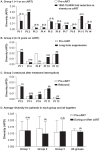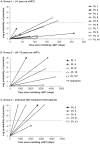Lack of detectable HIV-1 molecular evolution during suppressive antiretroviral therapy
- PMID: 24651464
- PMCID: PMC3961343
- DOI: 10.1371/journal.ppat.1004010
Lack of detectable HIV-1 molecular evolution during suppressive antiretroviral therapy
Abstract
A better understanding of changes in HIV-1 population genetics with combination antiretroviral therapy (cART) is critical for designing eradication strategies. We therefore analyzed HIV-1 genetic variation and divergence in patients' plasma before cART, during suppression on cART, and after viral rebound. Single-genome sequences of plasma HIV-1 RNA were obtained from HIV-1 infected patients prior to cART (N = 14), during suppression on cART (N = 14) and/or after viral rebound following interruption of cART (N = 5). Intra-patient population diversity was measured by average pairwise difference (APD). Population structure was assessed by phylogenetic analyses and a test for panmixia. Measurements of intra-population diversity revealed no significant loss of overall genetic variation in patients treated for up to 15 years with cART. A test for panmixia, however, showed significant changes in population structure in 2/10 patients after short-term cART (<1 year) and in 7/10 patients after long-term cART (1-15 years). The changes consisted of diverse sets of viral variants prior to cART shifting to populations containing one or more genetically uniform subpopulations during cART. Despite these significant changes in population structure, rebound virus after long-term cART had little divergence from pretherapy virus, implicating long-lived cells infected before cART as the source for rebound virus. The appearance of genetically uniform virus populations and the lack of divergence after prolonged cART and cART interruption provide strong evidence that HIV-1 persists in long-lived cells infected before cART was initiated, that some of these infected cells may be capable of proliferation, and that on-going cycles of viral replication are not evident.
Conflict of interest statement
John Mellors is a consultant for Gilead Sciences and owns share options in RFS Pharmaceuticals. This does not alter our adherence to all PLoS Pathogens policies on sharing data and materials.
Figures






References
-
- Coffin JM (1995) HIV population dynamics in vivo: implications for genetic variation, pathogenesis, and therapy. Science 267: 483–489. - PubMed
-
- Coffin JM (1996) HIV viral dynamics. Aids 10 Suppl 3: S75–84. - PubMed
-
- Perelson AS, Essunger P, Cao Y, Vesanen M, Hurley A, et al. (1997) Decay characteristics of HIV-1-infected compartments during combination therapy. Nature 387: 188–191. - PubMed
Publication types
MeSH terms
Substances
LinkOut - more resources
Full Text Sources
Other Literature Sources
Medical
Molecular Biology Databases

